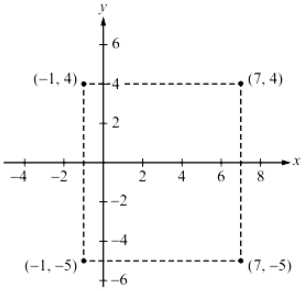GRE Mock Test (New Pattern) - 3 - GRE MCQ
30 Questions MCQ Test - GRE Mock Test (New Pattern) - 3
Directions: For each sentence, choose one word for each set of blanks. Select the word or words that best fit(s) the meaning of the sentence as a whole.
Q. A responsible business owner may easily feel ______ between her concern for the well-being of her employees and the challenges of financial shortfalls.
Directions: For each sentence, choose one word for each set of blanks. Select the word or words that best fit(s) the meaning of the sentence as a whole.
Q. The controversy surrounding the election dragged on for months, and the lack of a definite victor_____ governance and left people anxious about the future of their leadership.
Directions: For each sentence, choose one word for each set of blanks. Select the word or words that best fit(s) the meaning of the sentence as a whole.
Q. The busboy was known for his diligence rather than his celerity.
During his shifts, he worked (i) ________ when cleaning up after customers. Though the chef initially found it annoying, she came to appreciate having things done thoroughly rather than (ii) ________ .
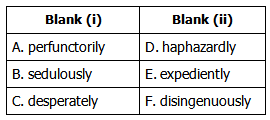

Direction: Select exactly two answer choices that best complete the sentence and produce sentences that are alike in meaning.
Q. As the job fair neared to an end, the recent college graduate became ever more ______, desperately trying to befriend prospective employers he had earlier not even deigned to give so much as a cursory glance.
The yoking of Mahabharata, a major epic of ancient India, to modern history needed a style as varied in tone, form, and (i) __________ as the epic itself, with its numerous (ii) __________ and digressions: the story of India had to come across as a tale of many tellers, even if it is (iii) __________ only to one.

Directions: For each sentence, choose one word for each set of blanks. Select the word or words that best fit(s) the meaning of the sentence as a whole.
Q. The middle school principal believed that even a minor (i) ________ the rules demanded his attention. Such a thing could not go (ii) ________ if he were to maintain discipline.
In his eyes, obedience and order were of the utmost importance.
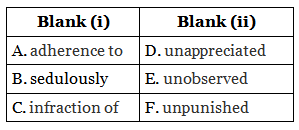
Directions: For each sentence, choose one word for each set of blanks. Select the word or words that best fit(s) the meaning of the sentence as a whole.
Q. Ms. Barnhart, unlike previous executives at the engineering firm, eschews the practice of managing every aspect of the day-to-day activities of her team of managers. Instead, she (i) ________ based on the annual business plan. Ms. Barnhartbelieves that her approach avoids (ii) ________ team morale, which would inevitably and unfortunately occur under (iii) ________ management style.

Directions: Answer the questions based on the following passage.
Ludwig Wittgenstein asserted that with the publication of his Tractatus Logico-Philosophicus he had solved all philosophical problems and retired to teach mathematics at the secondary level. He believed he had achieved this through his exploration of the logic of language, which he referred to as his “picture theory” of language.
Wittgenstein’s contention was that the world consisted of a collection of interconnected “facts” that created “pictures” of the world through propositions. These propositions are meaningful if they picture matters of empirical fact, such as “Meri is six feet tall.” In order for these linguistic pictures to accurately represent facts, they must have the same logical structure as matters of empirical fact.
The problem is that philosophical propositions, such as “truth is beauty,” are not matters of empirical fact. Since language itself is based on this relationship, philosophers cannot extricate themselves from the realm of language in order to actually say anything about whether or not the “pictures” have the same logical structure as the facts. One important consequence of this argument is that it is nonsensical to discuss philosophical problems. The propositions that philosophers commonly make are not technically wrong but nonsensical. For Wittgenstein, the ultimate goal of philosophy itself is not the actual study or pursuit of “truth.” Philosophy has more to do with clarifying the relationship between language and truth than truth itself. The Tractatus ends up subverting its own claims by concluding that the kind of propositions of which it is composed are senseless.
The most commonly quoted excerpt from the book is the proposition “What we cannot speak about we must pass over in silence.”
Q. The author believes Wittgenstein would likely agree with which of the following statements?
Directions: Answer the questions based on the following passage.
Ludwig Wittgenstein asserted that with the publication of his Tractatus Logico-Philosophicus he had solved all philosophical problems and retired to teach mathematics at the secondary level. He believed he had achieved this through his exploration of the logic of language, which he referred to as his “picture theory” of language.
Wittgenstein’s contention was that the world consisted of a collection of interconnected “facts” that created “pictures” of the world through propositions. These propositions are meaningful if they picture matters of empirical fact, such as “Meri is six feet tall.” In order for these linguistic pictures to accurately represent facts, they must have the same logical structure as matters of empirical fact.
The problem is that philosophical propositions, such as “truth is beauty,” are not matters of empirical fact. Since language itself is based on this relationship, philosophers cannot extricate themselves from the realm of language in order to actually say anything about whether or not the “pictures” have the same logical structure as the facts. One important consequence of this argument is that it is nonsensical to discuss philosophical problems. The propositions that philosophers commonly make are not technically wrong but nonsensical. For Wittgenstein, the ultimate goal of philosophy itself is not the actual study or pursuit of “truth.” Philosophy has more to do with clarifying the relationship between language and truth than truth itself. The Tractatus ends up subverting its own claims by concluding that the kind of propositions of which it is composed are senseless.
The most commonly quoted excerpt from the book is the proposition “What we cannot speak about we must pass over in silence.”
Q. Based on the context of the passage, the author’s use of the word “empirical” most nearly means which of the following?
Directions: Select the two answer choices that, when inserted into the sentence, fit the meaning of the sentence as a whole and yield complete sentences that are similar in meaning.
Q. Many Americans in the 1950s may have found the idea of a black president ______ , but societal changes since then have made this idea a reality.
Directions: Select the two answer choices that, when inserted into the sentence, fit the meaning of the sentence as a whole and yield complete sentences that are similar in meaning.
Q. Located in what is perhaps the most geographically remote state in the Union, Hawaii’s isolated Molokai Island is known for its hidden, untouched, and_____ beaches.
Directions: Select the two answer choices that, when inserted into the sentence, fit the meaning of the sentence as a whole and yield complete sentences that are similar in meaning.
Q. the doctor told Joe he needed to lose weight, so he began to make more_____ choices when going out to dinner.
Directions: Read the following passage and answer the question.
While days of the chain gang are long gone, the effects of meaningful labor during imprisonment demonstrate marked benefits to both the prisoner and society. Some of these benefits take the forms of reduced recidivism, increased job skills and employability, and improved quality of life. In fact, corporations have hired jails to have their inmates perform work from manufacturing to telemarketing.
However, some critics argue that prisoners who work are little more than bonded slaves, earning nothing for their labor and forced to do work that may be beyond their physical or mental capacity. Others are more concerned about the economic factors of cheap, noncompetitive labor or issues involved in giving inmates responsibility for critical components of products or providing them with lists of addresses and telephone numbers.
Q. The author would most likely agree with which of the following sentences?
Directions: Read the following passage and answer the question.
The Terracotta Army, 8,000 terracotta warrior figures guarding the tomb of the first Chinese emperor, Qin Shui Huang (259–210 ), was discovered in Xi’an in northwest China in 1974. The finding was remarkable not only for the sheer number of figures but for the intricate details of each sculpture. While it was a well-developed art form in ancient Greece, sculpture seems to have played only a minor role in ancient Asian art until the ascension of Qin Shui Huang. The variety of ear shapes, hairstyles, and armor among the figures has archaeologists pondering the possibility that the Terracotta Army may be representations of actual individual warriors. Such a level of detail is far beyond that of any known earlier Chinese sculptures.
Experts are searching for an explanation for this seemingly sudden appearance of sophisticated sculpture in ancient China. Recent DNA analysis of human remains found in westernmost China from the period of Qin Shui Huang yielded the surprising presence of European DNA, leading anthropologists to believe that Western contact with China may significantly predate the Silk Road, usually considered the inception of the relationship between these two civilizations. What is even more remarkable, however, is one of the responses to this discovery. Professor Lukas Nickel, an art historian from the University of Vienna, speculates that the presence of the DNA indicates that a Greek sculptor may have been employed at the site of the Terracotta Army to train the locals. Nickel also cites ancient Chinese records that reveal tales of giant statues appearing in the far West, as well as narratives stating that the emperor ordered the casting of copies in bronze that were erected in front of his palace. This account supports the notion of early contact between China and the West, which Nickel says could have inspired the First Emperor not only to duplicate the giant statues but also to build the huge Terracotta Army along with other life-size sculptures. Li Xiuzhen, a Chinese archaeologist specializing in the Terracotta Army, responds that the sculptures “may be inspired by Western culture, but were uniquely made by the Chinese.”
Nickel’s leap from the presence of European DNA in one part of China to his conclusion strains credulity. It is, at best, an interesting hypothesis demanding further evidence and, at worst, a pernicious example of Western cultural elitism wherein artistic developments that parallel or exceed those of Western culture are considered impossible without the impetus of Western influence.
Q. The primary purpose of the passage is to
Directions: Read the following passage and answer the question.
The Terracotta Army, 8,000 terracotta warrior figures guarding the tomb of the first Chinese emperor, Qin Shui Huang (259–210 ), was discovered in Xi’an in northwest China in 1974. The finding was remarkable not only for the sheer number of figures but for the intricate details of each sculpture. While it was a well-developed art form in ancient Greece, sculpture seems to have played only a minor role in ancient Asian art until the ascension of Qin Shui Huang. The variety of ear shapes, hairstyles, and armor among the figures has archaeologists pondering the possibility that the Terracotta Army may be representations of actual individual warriors. Such a level of detail is far beyond that of any known earlier Chinese sculptures.
Experts are searching for an explanation for this seemingly sudden appearance of sophisticated sculpture in ancient China. Recent DNA analysis of human remains found in westernmost China from the period of Qin Shui Huang yielded the surprising presence of European DNA, leading anthropologists to believe that Western contact with China may significantly predate the Silk Road, usually considered the inception of the relationship between these two civilizations. What is even more remarkable, however, is one of the responses to this discovery. Professor Lukas Nickel, an art historian from the University of Vienna, speculates that the presence of the DNA indicates that a Greek sculptor may have been employed at the site of the Terracotta Army to train the locals. Nickel also cites ancient Chinese records that reveal tales of giant statues appearing in the far West, as well as narratives stating that the emperor ordered the casting of copies in bronze that were erected in front of his palace. This account supports the notion of early contact between China and the West, which Nickel says could have inspired the First Emperor not only to duplicate the giant statues but also to build the huge Terracotta Army along with other life-size sculptures. Li Xiuzhen, a Chinese archaeologist specializing in the Terracotta Army, responds that the sculptures “may be inspired by Western culture, but were uniquely made by the Chinese.”
Nickel’s leap from the presence of European DNA in one part of China to his conclusion strains credulity. It is, at best, an interesting hypothesis demanding further evidence and, at worst, a pernicious example of Western cultural elitism wherein artistic developments that parallel or exceed those of Western culture are considered impossible without the impetus of Western influence.
Q. The passage implies which of the following about the sculptures of the Terracotta Army?
Directions: Compare Quantity A and Quantity B, using additional information centered above the two quantities if such information is given. Select one of the following four answer choices and fill in the corresponding oval to the right of the question. A symbol that appears more than once in a question has the same meaning throughout the question.
The length of each side of rectangle R is an integer, and the
area of R is 36.
Quantity A - The number of possible values of the perimeter of R
Quantity B - 6
Directions: Compare Quantity A and Quantity B, using additional information centered above the two quantities if such information is given. Select one of the following four answer choices and fill in the corresponding oval to the right of the question. A symbol that appears more than once in a question has the same meaning throughout the question.
Q. x, y, and z are the lengths of the sides of a triangle.
Quantity A - x + y + z
Quantity B - 2z
Directions: Compare Quantity A and Quantity B, using additional information centered above the two quantities if such information is given. Select one of the following four answer choices and fill in the corresponding oval to the right of the question. A symbol that appears more than once in a question has the same meaning throughout the question.
Q. At a club meeting, there are 10 more club members
than nonmembers. The number of club members at the meeting is c.
Quantity A - The total number of people at the club meeting
Quantity B - 2c − 10
Directions: Select a single answer choice.
Q. In the xy-plane, a quadrilateral has vertices at (-1, 4), (7, 4), (7, -5), and (-1, -5). What is the perimeter of the quadrilateral?
Directions: Select a single answer choice.
Q. In right triangle ABC, the ratio of the lengths of the two legs is 2 to 5. If the area of triangle ABC is 20, what is the length of the hypotenuse?
Directions: Compare Quantity A and Quantity B, using additional information centered above the two quantities if such information is given. Select one of the following four answer choices and fill in the corresponding oval to the right of the question. A symbol that appears more than once in a question has the same meaning throughout the question.
Q.
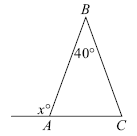
AB = BC
Quantity A - x
Quantity B - 120
Directions: Your answer may be an integer, a decimal, or a fraction, and it may be negative. Enter the exact answer unless the question asks you to round your answer.
Q. In a single line of people waiting to purchase tickets for a movie, there are currently 10 people behind Shandra. If 3 of the people who are currently in line ahead of Shandra purchase tickets and leave the line, and no one else leaves the line, there will be 8 people ahead of Shandra in line. How many people are in the line currently?
Directions: Compare Quantity A and Quantity B, using additional information centered above the two quantities if such information is given. Select one of the following four answer choices and fill in the corresponding oval to the right of the question. A symbol that appears more than once in a question has the same meaning throughout the question.
Q. n is a positive integer that is greater than 3 and has d positive divisors.
Quantity A - n
Quantity B - 2d-1
Directions: Compare Quantity A and Quantity B, using additional information centered above the two quantities if such information is given. Select one of the following four answer choices and fill in the corresponding oval to the right of the question. A symbol that appears more than once in a question has the same meaning throughout the question.
Q. xy = 8 and x = y − 2.
Quantity A - y
Quantity B - 0
Directions: Select a single answer choice.
Q. The area of circle W is 16π and the area of circle Z is 4π. What is the ratio of the circumference of W to the circumference of Z?
Directions: Select a single answer choice.
Q. If 10x equals 0.1 percent of 10y, where x and y are integers, which of the following must be true?
Selected Data For Greeting Card Sales
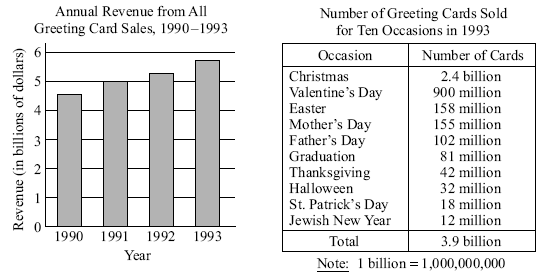
Q. In 1993 the number of Valentine’s Day cards sold was approximately how many times the number of Thanksgiving cards sold?
Selected Data For Greeting Card Sales
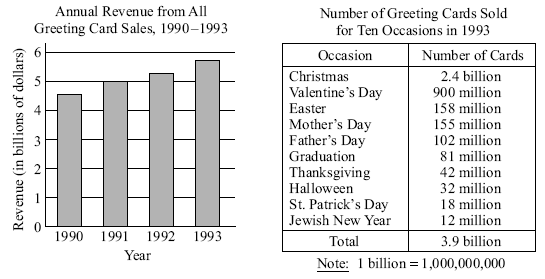
Q. In 1993 a card company that sold 40 percent of the Mother’s Day cards that year priced its cards for that occasion between $1.00 and $8.00 each. If the revenue from sales of the company’s Mother’s Day cards in 1993 was r million dollars, which of the following indicates all possible values of r?
Directions: Select a single answer choice.
Q. The greatest of the 21 positive integers in a certain list is 16. The median of the 21 integers is 10. What is the least possible average (arithmetic mean) of the 21 integers?
Directions: Select a single answer choice.
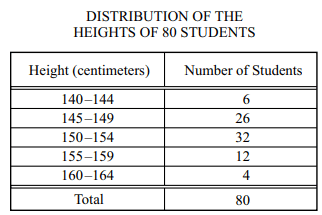
Q. The table above shows the frequency distribution of the heights of 80 students, where the heights are recorded to the nearest centimeter. What is the least possible range of the recorded heights of the 80 students?



